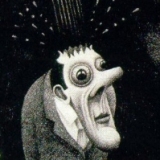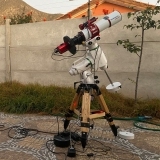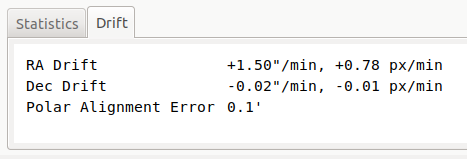INDI Library v2.0.7 is Released (01 Apr 2024)
Bi-monthly release with minor bug fixes and improvements
Polar Alignment - Kudos to the EKOS team!
Polar Alignment - Kudos to the EKOS team! was created by fmozza
jmh
Please Log in or Create an account to join the conversation.
- Charles Wright
-

- Offline
- Premium Member
-

- Posts: 94
- Thank you received: 8
Replied by Charles Wright on topic Polar Alignment - Kudos to the EKOS team!
Thanks,
Charles
Mounts: CEM-60 chiefly; iEQ45
Cameras: Atik 383L+, QHY5-II-M
Focuser: Moonlite
Please Log in or Create an account to join the conversation.
- Jasem Mutlaq
-

- Online
- Administrator
-

Replied by Jasem Mutlaq on topic Polar Alignment - Kudos to the EKOS team!
Please Log in or Create an account to join the conversation.
Replied by fmozza on topic Polar Alignment - Kudos to the EKOS team!
I have an unobstructed view of Polaris and NCP, and a clear view to the east, and the meridian to about -5 degrees south. (Presumably you're asking about drift alignment if you are asking about the east/west star? I was using the EKOS Polar alignment bits, not drift alignment).
I changed my imaging telescope, so I re-did the Polar alignment as the imaging axis would likely be different between the two telescopes. The value I reported above is an estimate obtained from phdlogview after about an hour or so of guiding.
If I recall, EKOS polar alignment reported that the alignment of off by about 5 arcmin or so, so not much and the adjustments were minor. I was happy I could get it that close with little effort, compared to drift alignment.
jmh
Please Log in or Create an account to join the conversation.
Replied by fmozza on topic Polar Alignment - Kudos to the EKOS team!
I used the most recent stable KStars, not a nightly KStars build. If you recall my original post on this module back in July where we discovered the correction vector direction issues, I've encountered the problem perhaps about 25% of the time and simpy redo the alignment if I pick the wrong direction.
I saw your request for feedback. I've had lots of cloudy nights lately, but it is supposed to be clear again tomorrow night , so I'll have another crack at it if I have time. Did you want me to test using the latest nightly?
jmh
Please Log in or Create an account to join the conversation.
- Charles Wright
-

- Offline
- Premium Member
-

- Posts: 94
- Thank you received: 8
Replied by Charles Wright on topic Polar Alignment - Kudos to the EKOS team!
Also, knowing what focal length you are imaging at and your exposure times would be helpful to get a sense of how the alignment quality helps you.
Charles
Mounts: CEM-60 chiefly; iEQ45
Cameras: Atik 383L+, QHY5-II-M
Focuser: Moonlite
Please Log in or Create an account to join the conversation.
- Wouter van Reeven
-

- Offline
- Supernova Explorer
-

- Posts: 1957
- Thank you received: 420
Replied by Wouter van Reeven on topic Polar Alignment - Kudos to the EKOS team!
If you have a clear view at Polaris (or the southern celestial pole when in the southern hemisphere) then there is a much simpler polar alignment procedure nowadays. Simply point your telescope with camera at Polaris, go to the Alignment tab, select Polar Alignment and click start. This will take an image and plate solve it, rotate the mount 30 degrees westward (or east if you selected that), take another image, rotate 30 degrees more and take a third image. Then the three images are used to compute the polar alignment error, which will show up in the last image as a pink arrow. Click any star and the pink arrow will start there. Then use the alignment knobs of your mount to move the star to the other end of the arrow and you're done.
HTH, Wouter
Please Log in or Create an account to join the conversation.
- Wes Creech
-

- Offline
- Premium Member
-

- Posts: 86
- Thank you received: 9
Replied by Wes Creech on topic Polar Alignment - Kudos to the EKOS team!
Please Log in or Create an account to join the conversation.
Replied by fmozza on topic Polar Alignment - Kudos to the EKOS team!
I wasn't following the process you describe - I think the documentation is out of date. My understanding is the new process uses plate solving to get an accurate measure of the centre of rotation by calculating 3 points on a circle, and then a vector is computed to move the centre-of-rotation to NCP. The direction of the vector was the only point in question when I ran into problems last July - not sure this has been resolved yet.
For this alignment, I was imaging at a focal length of 900 (f7.5). Take a look at Polar Alignment for more details. When it works, it works well. The work-around for the vector direction issue is to redo the alignment and move it in the opposite direction.
jmh
Please Log in or Create an account to join the conversation.
- Charles Wright
-

- Offline
- Premium Member
-

- Posts: 94
- Thank you received: 8
Replied by Charles Wright on topic Polar Alignment - Kudos to the EKOS team!
Can't wait to try this new alignment method, since I *do* have a clear view of the pole. I typically do a first focus adjust pointing at the pole anyway, so this sounds super easy.
Thanks so much!
Charles
Mounts: CEM-60 chiefly; iEQ45
Cameras: Atik 383L+, QHY5-II-M
Focuser: Moonlite
Please Log in or Create an account to join the conversation.
- Jasem Mutlaq
-

- Online
- Administrator
-

Replied by Jasem Mutlaq on topic Polar Alignment - Kudos to the EKOS team!
Please Log in or Create an account to join the conversation.
Replied by fmozza on topic Polar Alignment - Kudos to the EKOS team!
I've never done that and the few times I've checked my cone error, it's been pretty small. My maximum exposure is typically 10 minutes, and I work backwards, using my polar alignment to compute the amount of rotation I would see for a given exposure.
My biggest issue tends to be related to cabling, especially when it gets cold and the cables become rigid - my guiding RMS will increase by .1 to .2 arcseconds.
If you are using PHD2 for guiding, they have a paper that recommends a polar alignment that is slightly off to avoid DEC oscillating back and forth. I have been successful setting a larger DEC min move and using the Z-filter option to guide DEC. I do pay attention to the difference between DEC and RA guiding as it can lead to oval stars - they should be close.
If you have a long focal length and intend to use long exposures, then you will at least need to use some form of off-axis guiding. The EKOS alignment module works very well to get very good alignment and typically won't be the limiting factor for your imaging requirements.
What is your imaging setup?
jmh
Please Log in or Create an account to join the conversation.

